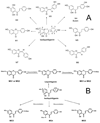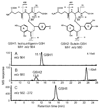Cancer chemopreventive activity and metabolism of isoliquiritigenin, a compound found in licorice
- PMID: 20068129
- PMCID: PMC2818593
- DOI: 10.1158/1940-6207.CAPR-09-0049
Cancer chemopreventive activity and metabolism of isoliquiritigenin, a compound found in licorice
Abstract
Isoliquiritigenin (2',4',4-trihydroxychalcone; ILG), a chalcone found in licorice root and many other plants, has shown potential chemopreventive activity through induction of phase II enzymes such as quinone reductase-1 in murine hepatoma cells. In this study, the in vivo metabolism of ILG was investigated in rats. In addition, ILG glucuronides and ILG-glutathione adducts were observed in human hepatocytes and in livers from rats treated with ILG. ILG glucuronides were detected in both plasma and rat liver tissues. In addition, in a full-term cancer chemoprevention study conducted with 7,12-dimethylbenz(a)anthracene-treated female Sprague-Dawley rats, dietary administration of ILG slightly increased tumor latency but had a negative effect on the incidence of mammary tumors starting at approximately 65 days after 7,12-dimethylbenz(a)anthracene administration. Further, no significant induction of phase II enzymes was found in mammary glands, which is consistent with the low level of ILG observed in these tissues. However, ILG significantly induced quinone reductase-1 activity in the colon, and glutathione as well as glutathione S-transferase in the liver. Analysis of mRNA expression in tissues of rats treated with ILG supported these findings. These results suggest that ILG should be tested for chemopreventive efficacy in nonmammary models of cancer.
Figures






 ). Induction was calculated by comparing group 2 (DMBA and 7.5 g/kg diet of ILG) and group 3 (DMBA and 10.0 g/kg diet of ILG) with group 1 (DMBA in sesame oil), and group 4 (10.0 g/kg diet of ILG) with group 5 (basal diet). Treatment groups were significantly different (p<0.05) from the DMBA only control group 1 (*) or from the basal diet control group 5 (**) with n = 6.
). Induction was calculated by comparing group 2 (DMBA and 7.5 g/kg diet of ILG) and group 3 (DMBA and 10.0 g/kg diet of ILG) with group 1 (DMBA in sesame oil), and group 4 (10.0 g/kg diet of ILG) with group 5 (basal diet). Treatment groups were significantly different (p<0.05) from the DMBA only control group 1 (*) or from the basal diet control group 5 (**) with n = 6.Similar articles
-
Induction of NAD(P)H:Quinone Oxidoreductase 1 (NQO1) by Glycyrrhiza Species Used for Women's Health: Differential Effects of the Michael Acceptors Isoliquiritigenin and Licochalcone A.Chem Res Toxicol. 2015 Nov 16;28(11):2130-41. doi: 10.1021/acs.chemrestox.5b00310. Epub 2015 Nov 5. Chem Res Toxicol. 2015. PMID: 26473469 Free PMC article.
-
Cancer chemopreventive activity mediated by 4'-bromoflavone, a potent inducer of phase II detoxification enzymes.Cancer Res. 1999 Feb 1;59(3):578-85. Cancer Res. 1999. PMID: 9973203
-
Hepatic metabolism of licochalcone A, a potential chemopreventive chalcone from licorice (Glycyrrhiza inflata), determined using liquid chromatography-tandem mass spectrometry.Anal Bioanal Chem. 2017 Dec;409(30):6937-6948. doi: 10.1007/s00216-017-0642-x. Epub 2017 Nov 10. Anal Bioanal Chem. 2017. PMID: 29127460 Free PMC article.
-
Vanadium chemoprevention of 7,12-dimethylbenz(a)anthracene-induced rat mammary carcinogenesis: probable involvement of representative hepatic phase I and II xenobiotic metabolizing enzymes.Breast Cancer Res Treat. 2000 Sep;63(2):133-45. doi: 10.1023/a:1006476003685. Breast Cancer Res Treat. 2000. PMID: 11097089
-
Quinone reductase induction as a biomarker for cancer chemoprevention.J Nat Prod. 2006 Mar;69(3):460-3. doi: 10.1021/np050362q. J Nat Prod. 2006. PMID: 16562858 Free PMC article. Review.
Cited by
-
Chalcone-based inhibitors against hypoxia-inducible factor 1--structure activity relationship studies.Bioorg Med Chem Lett. 2011 Jan 1;21(1):555-7. doi: 10.1016/j.bmcl.2010.10.063. Epub 2010 Oct 20. Bioorg Med Chem Lett. 2011. PMID: 21112783 Free PMC article.
-
Glycyrrhiza glabra (Licorice): A Comprehensive Review on Its Phytochemistry, Biological Activities, Clinical Evidence and Toxicology.Plants (Basel). 2021 Dec 14;10(12):2751. doi: 10.3390/plants10122751. Plants (Basel). 2021. PMID: 34961221 Free PMC article. Review.
-
Development of Safe and Effective Botanical Dietary Supplements.J Med Chem. 2015 Nov 12;58(21):8360-72. doi: 10.1021/acs.jmedchem.5b00417. Epub 2015 Jul 21. J Med Chem. 2015. PMID: 26125082 Free PMC article.
-
Simultaneous Determination and Pharmacokinetic Characterization of Glycyrrhizin, Isoliquiritigenin, Liquiritigenin, and Liquiritin in Rat Plasma Following Oral Administration of Glycyrrhizae Radix Extract.Molecules. 2019 May 10;24(9):1816. doi: 10.3390/molecules24091816. Molecules. 2019. PMID: 31083444 Free PMC article.
-
Dietary compound isoliquiritigenin prevents mammary carcinogenesis by inhibiting breast cancer stem cells through WIF1 demethylation.Oncotarget. 2015;6(12):9854-76. doi: 10.18632/oncotarget.3396. Oncotarget. 2015. PMID: 25918249 Free PMC article.
References
-
- Kang Y, Pezzuto J. Induction of quinone reductase as a primary screen for natural product anticarcinogens. Methods Enzymol. 2004;382:380–414. - PubMed
-
- Cao Y, Wang Y, Ji C, Ye J. Determination of liquiritigenin and isoliquiritigenin in Glycyrrhiza uralensis and its medicinal preparations by capillary electrophoresis with electrochemical detection. J Chromatogr A. 2004;1042:203–209. - PubMed
-
- Ramadan M, Kamel M, Ohtani K, Kasai R, Yamasaki K. Minor phenolics from Crinum bulbispermum bulbs. Phytochemistry. 2000;54:891–896. - PubMed
-
- Pan X, Kong L, Zhang Y, Cheng C, Tan R. In vitro inhibition of rat monoamine oxidase by liquiritigenin and isoliquiritigenin isolated from Sinofranchetia chinensis. Acta Pharmacol Sin. 2000;21:949–953. - PubMed
Publication types
MeSH terms
Substances
Grants and funding
LinkOut - more resources
Full Text Sources
Other Literature Sources
Medical

